Human Resource Management in Business: Strategies and Practices
VerifiedAdded on 2023/06/18
|7
|1839
|195
Report
AI Summary
This report provides an overview of human resource management (HRM) within a business context, emphasizing the importance of effective strategies and practices. It delves into internal factors such as financial and marketing strategies, and external factors like social, legal, political, and technological changes that impact human resource planning. The report also identifies crucial employee skills such as communication, teamwork, responsibility, and creativity. Furthermore, it outlines methods for motivating employees, including rewards, effective workplace environments, and supportive management, as well as strategies for obtaining employee cooperation through cross-training and company policies. Finally, the document explains methods for measuring and managing employee performance, including self-evaluation, management by objectives, and 360-degree feedback. The study concludes that effective HRM is crucial for improving employee and business performance, fostering long-term sustainability, and driving business growth. Desklib provides a platform to access this and many other solved assignments.
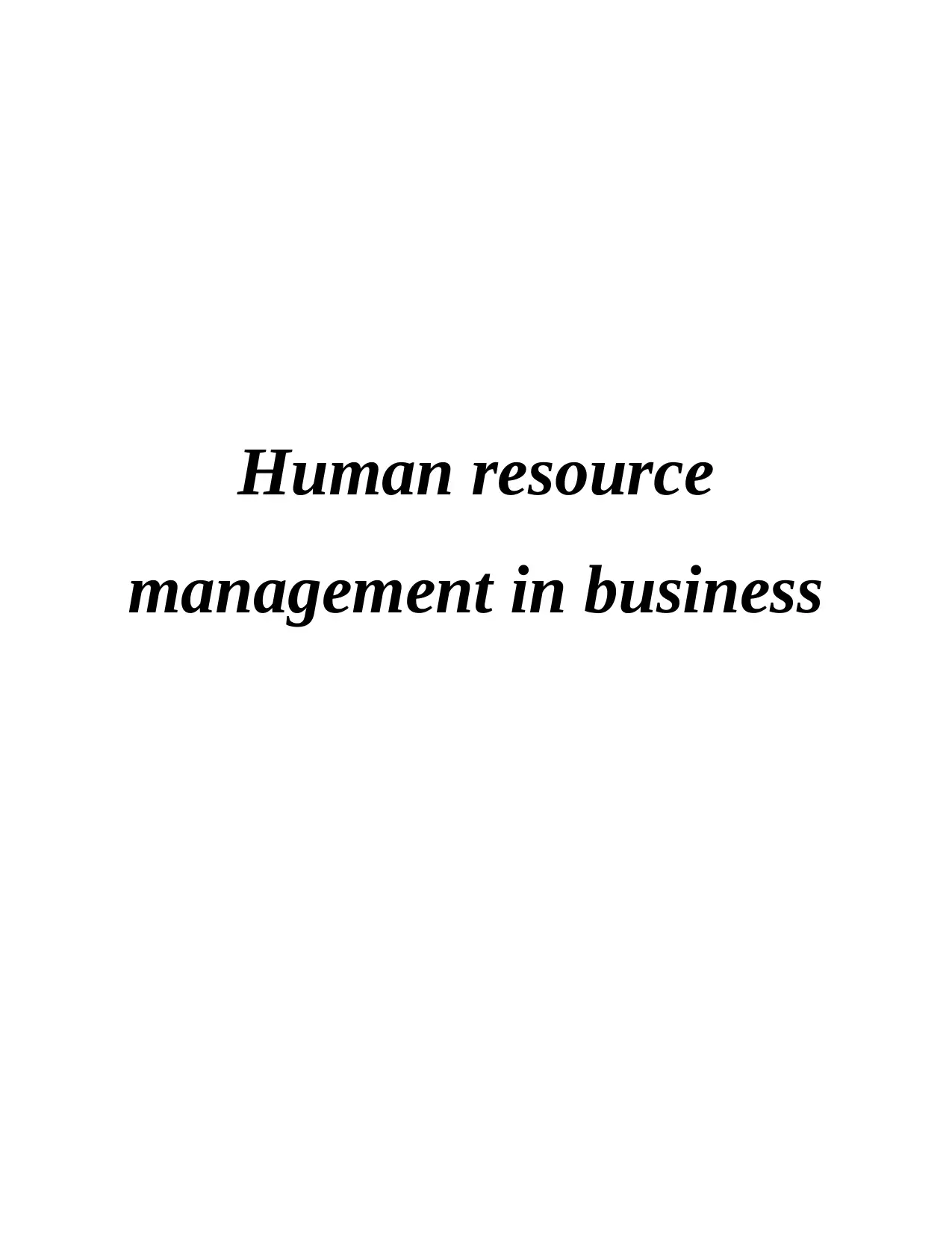
Human resource
management in business
management in business
Paraphrase This Document
Need a fresh take? Get an instant paraphrase of this document with our AI Paraphraser
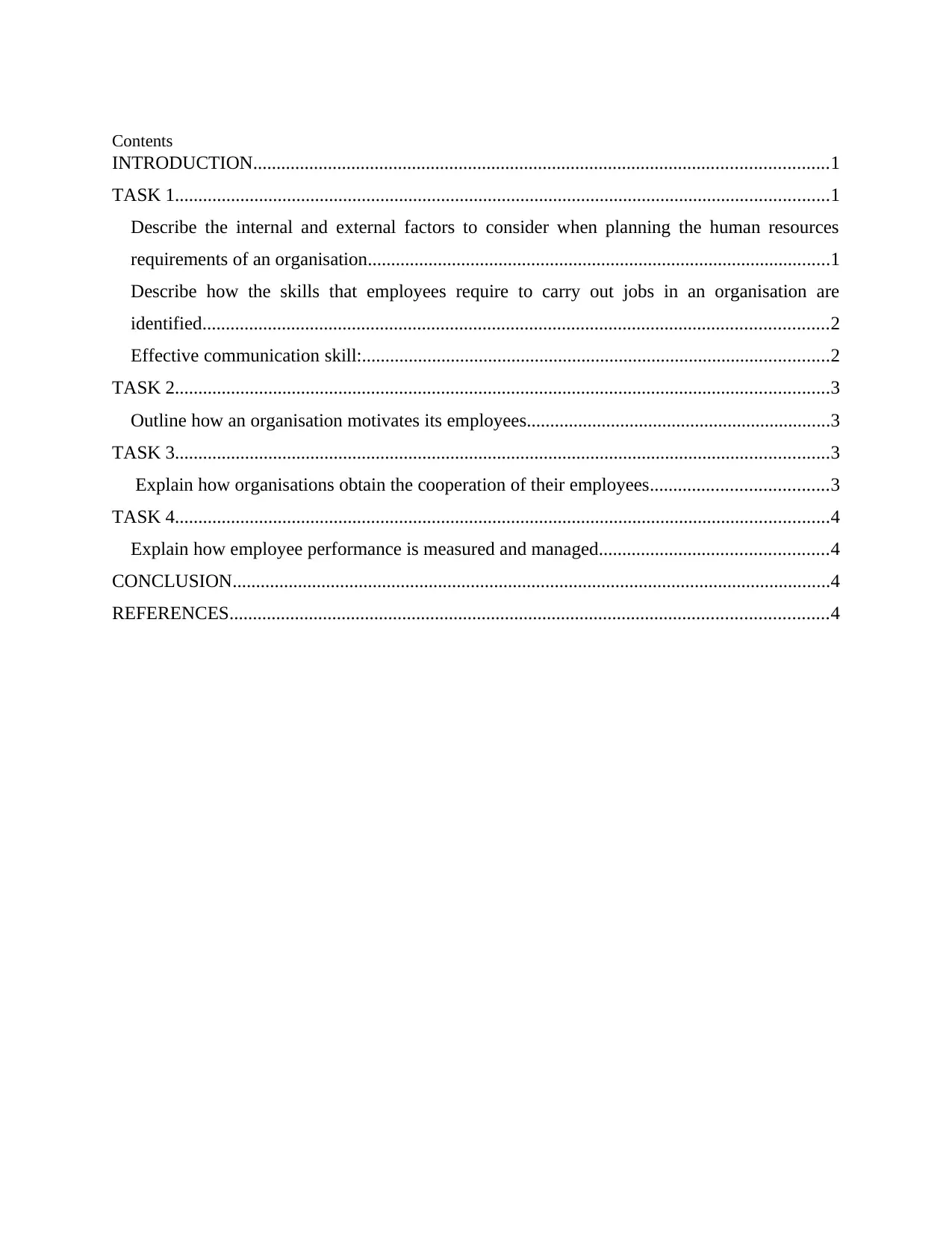
Contents
INTRODUCTION...........................................................................................................................1
TASK 1............................................................................................................................................1
Describe the internal and external factors to consider when planning the human resources
requirements of an organisation...................................................................................................1
Describe how the skills that employees require to carry out jobs in an organisation are
identified......................................................................................................................................2
Effective communication skill:....................................................................................................2
TASK 2............................................................................................................................................3
Outline how an organisation motivates its employees.................................................................3
TASK 3............................................................................................................................................3
Explain how organisations obtain the cooperation of their employees......................................3
TASK 4............................................................................................................................................4
Explain how employee performance is measured and managed.................................................4
CONCLUSION................................................................................................................................4
REFERENCES................................................................................................................................4
INTRODUCTION...........................................................................................................................1
TASK 1............................................................................................................................................1
Describe the internal and external factors to consider when planning the human resources
requirements of an organisation...................................................................................................1
Describe how the skills that employees require to carry out jobs in an organisation are
identified......................................................................................................................................2
Effective communication skill:....................................................................................................2
TASK 2............................................................................................................................................3
Outline how an organisation motivates its employees.................................................................3
TASK 3............................................................................................................................................3
Explain how organisations obtain the cooperation of their employees......................................3
TASK 4............................................................................................................................................4
Explain how employee performance is measured and managed.................................................4
CONCLUSION................................................................................................................................4
REFERENCES................................................................................................................................4
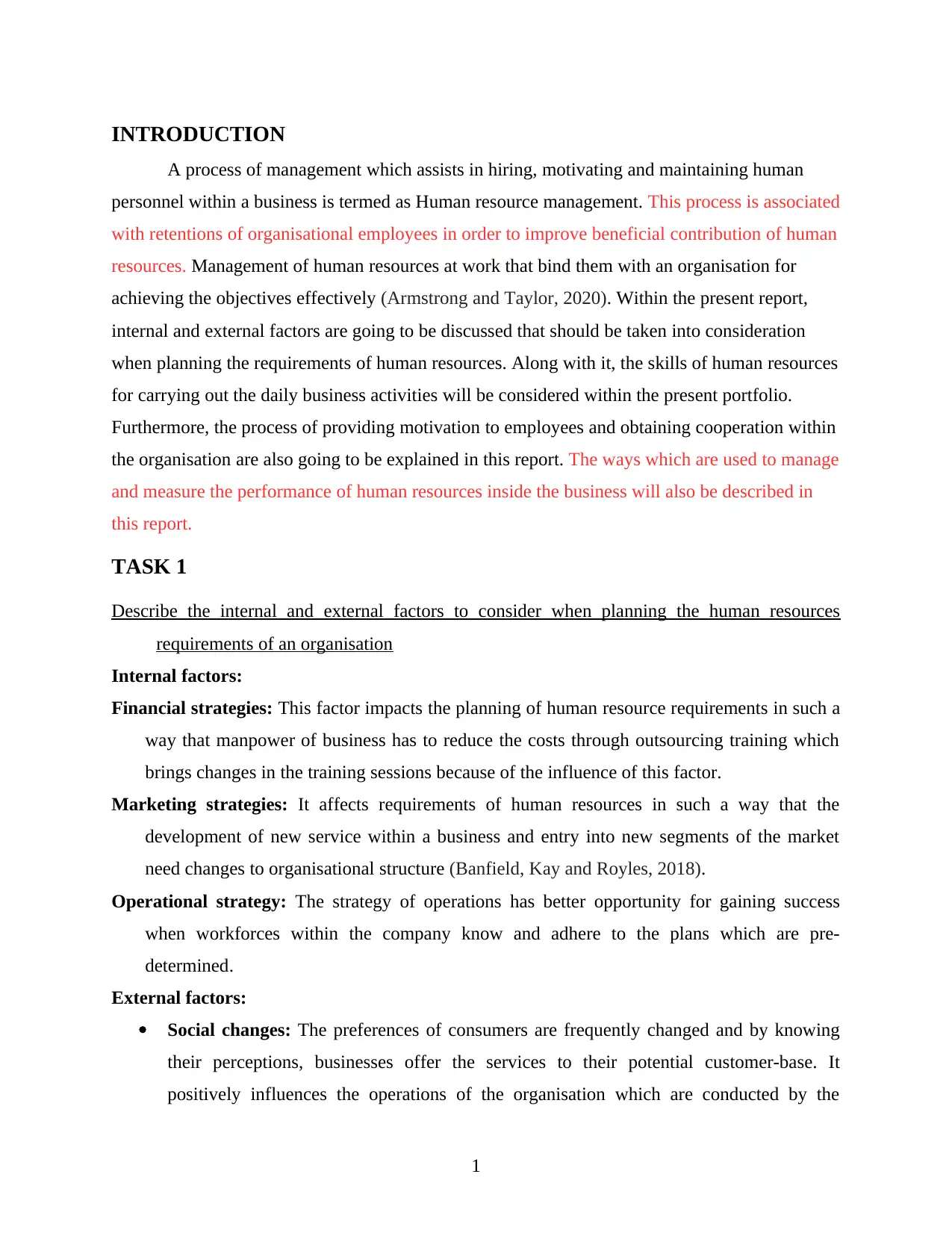
INTRODUCTION
A process of management which assists in hiring, motivating and maintaining human
personnel within a business is termed as Human resource management. This process is associated
with retentions of organisational employees in order to improve beneficial contribution of human
resources. Management of human resources at work that bind them with an organisation for
achieving the objectives effectively (Armstrong and Taylor, 2020). Within the present report,
internal and external factors are going to be discussed that should be taken into consideration
when planning the requirements of human resources. Along with it, the skills of human resources
for carrying out the daily business activities will be considered within the present portfolio.
Furthermore, the process of providing motivation to employees and obtaining cooperation within
the organisation are also going to be explained in this report. The ways which are used to manage
and measure the performance of human resources inside the business will also be described in
this report.
TASK 1
Describe the internal and external factors to consider when planning the human resources
requirements of an organisation
Internal factors:
Financial strategies: This factor impacts the planning of human resource requirements in such a
way that manpower of business has to reduce the costs through outsourcing training which
brings changes in the training sessions because of the influence of this factor.
Marketing strategies: It affects requirements of human resources in such a way that the
development of new service within a business and entry into new segments of the market
need changes to organisational structure (Banfield, Kay and Royles, 2018).
Operational strategy: The strategy of operations has better opportunity for gaining success
when workforces within the company know and adhere to the plans which are pre-
determined.
External factors:
Social changes: The preferences of consumers are frequently changed and by knowing
their perceptions, businesses offer the services to their potential customer-base. It
positively influences the operations of the organisation which are conducted by the
1
A process of management which assists in hiring, motivating and maintaining human
personnel within a business is termed as Human resource management. This process is associated
with retentions of organisational employees in order to improve beneficial contribution of human
resources. Management of human resources at work that bind them with an organisation for
achieving the objectives effectively (Armstrong and Taylor, 2020). Within the present report,
internal and external factors are going to be discussed that should be taken into consideration
when planning the requirements of human resources. Along with it, the skills of human resources
for carrying out the daily business activities will be considered within the present portfolio.
Furthermore, the process of providing motivation to employees and obtaining cooperation within
the organisation are also going to be explained in this report. The ways which are used to manage
and measure the performance of human resources inside the business will also be described in
this report.
TASK 1
Describe the internal and external factors to consider when planning the human resources
requirements of an organisation
Internal factors:
Financial strategies: This factor impacts the planning of human resource requirements in such a
way that manpower of business has to reduce the costs through outsourcing training which
brings changes in the training sessions because of the influence of this factor.
Marketing strategies: It affects requirements of human resources in such a way that the
development of new service within a business and entry into new segments of the market
need changes to organisational structure (Banfield, Kay and Royles, 2018).
Operational strategy: The strategy of operations has better opportunity for gaining success
when workforces within the company know and adhere to the plans which are pre-
determined.
External factors:
Social changes: The preferences of consumers are frequently changed and by knowing
their perceptions, businesses offer the services to their potential customer-base. It
positively influences the operations of the organisation which are conducted by the
1
⊘ This is a preview!⊘
Do you want full access?
Subscribe today to unlock all pages.

Trusted by 1+ million students worldwide
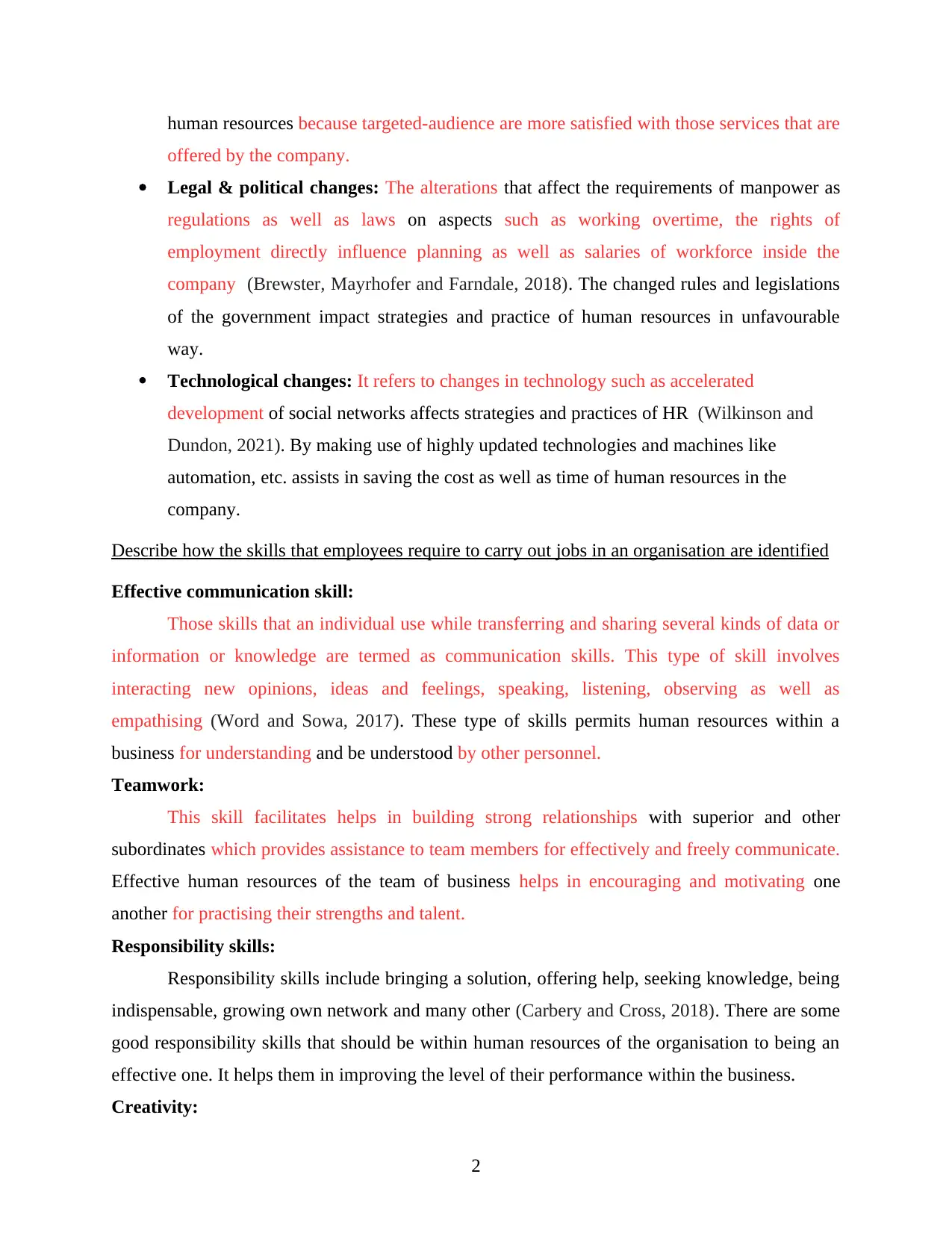
human resources because targeted-audience are more satisfied with those services that are
offered by the company.
Legal & political changes: The alterations that affect the requirements of manpower as
regulations as well as laws on aspects such as working overtime, the rights of
employment directly influence planning as well as salaries of workforce inside the
company (Brewster, Mayrhofer and Farndale, 2018). The changed rules and legislations
of the government impact strategies and practice of human resources in unfavourable
way.
Technological changes: It refers to changes in technology such as accelerated
development of social networks affects strategies and practices of HR (Wilkinson and
Dundon, 2021). By making use of highly updated technologies and machines like
automation, etc. assists in saving the cost as well as time of human resources in the
company.
Describe how the skills that employees require to carry out jobs in an organisation are identified
Effective communication skill:
Those skills that an individual use while transferring and sharing several kinds of data or
information or knowledge are termed as communication skills. This type of skill involves
interacting new opinions, ideas and feelings, speaking, listening, observing as well as
empathising (Word and Sowa, 2017). These type of skills permits human resources within a
business for understanding and be understood by other personnel.
Teamwork:
This skill facilitates helps in building strong relationships with superior and other
subordinates which provides assistance to team members for effectively and freely communicate.
Effective human resources of the team of business helps in encouraging and motivating one
another for practising their strengths and talent.
Responsibility skills:
Responsibility skills include bringing a solution, offering help, seeking knowledge, being
indispensable, growing own network and many other (Carbery and Cross, 2018). There are some
good responsibility skills that should be within human resources of the organisation to being an
effective one. It helps them in improving the level of their performance within the business.
Creativity:
2
offered by the company.
Legal & political changes: The alterations that affect the requirements of manpower as
regulations as well as laws on aspects such as working overtime, the rights of
employment directly influence planning as well as salaries of workforce inside the
company (Brewster, Mayrhofer and Farndale, 2018). The changed rules and legislations
of the government impact strategies and practice of human resources in unfavourable
way.
Technological changes: It refers to changes in technology such as accelerated
development of social networks affects strategies and practices of HR (Wilkinson and
Dundon, 2021). By making use of highly updated technologies and machines like
automation, etc. assists in saving the cost as well as time of human resources in the
company.
Describe how the skills that employees require to carry out jobs in an organisation are identified
Effective communication skill:
Those skills that an individual use while transferring and sharing several kinds of data or
information or knowledge are termed as communication skills. This type of skill involves
interacting new opinions, ideas and feelings, speaking, listening, observing as well as
empathising (Word and Sowa, 2017). These type of skills permits human resources within a
business for understanding and be understood by other personnel.
Teamwork:
This skill facilitates helps in building strong relationships with superior and other
subordinates which provides assistance to team members for effectively and freely communicate.
Effective human resources of the team of business helps in encouraging and motivating one
another for practising their strengths and talent.
Responsibility skills:
Responsibility skills include bringing a solution, offering help, seeking knowledge, being
indispensable, growing own network and many other (Carbery and Cross, 2018). There are some
good responsibility skills that should be within human resources of the organisation to being an
effective one. It helps them in improving the level of their performance within the business.
Creativity:
2
Paraphrase This Document
Need a fresh take? Get an instant paraphrase of this document with our AI Paraphraser
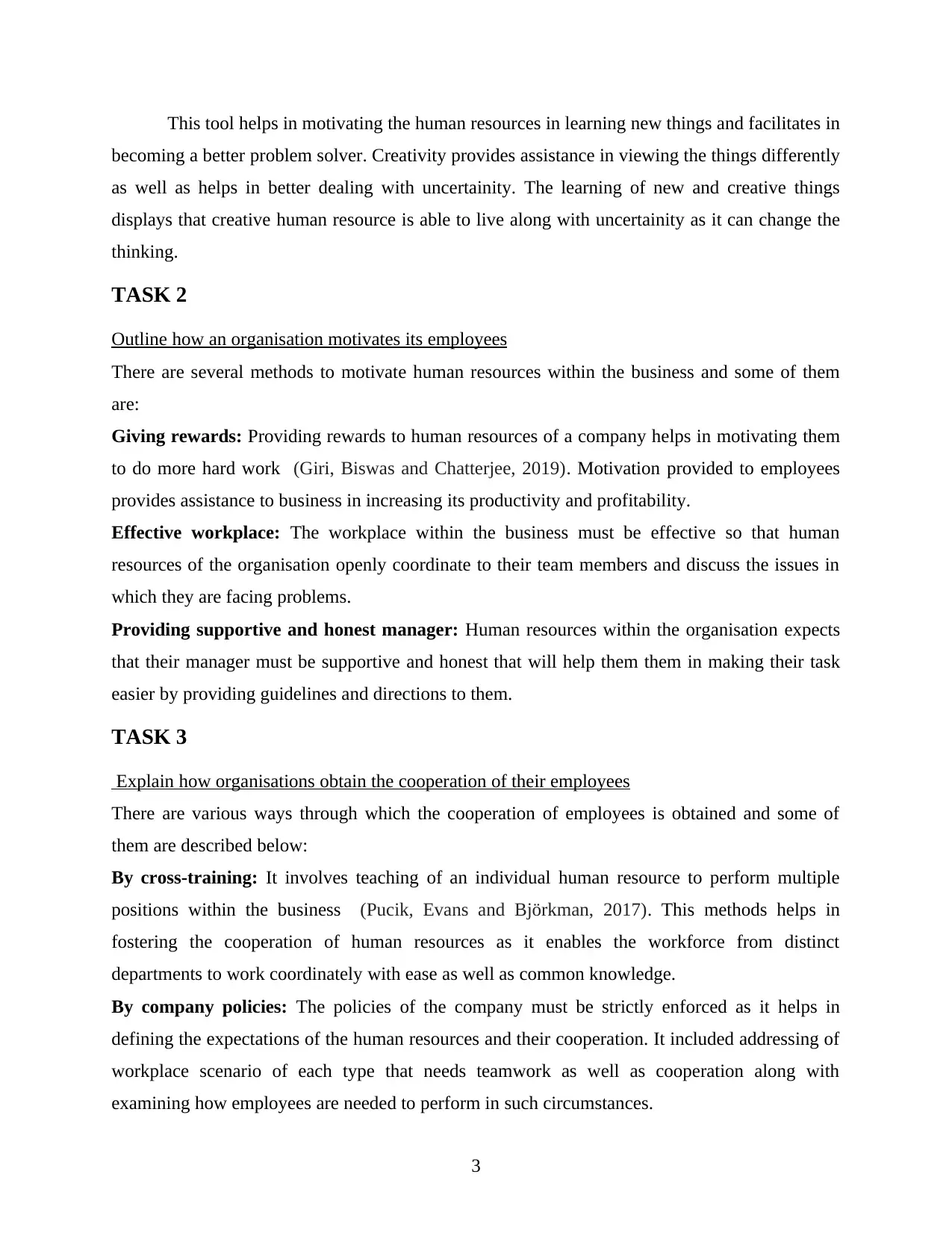
This tool helps in motivating the human resources in learning new things and facilitates in
becoming a better problem solver. Creativity provides assistance in viewing the things differently
as well as helps in better dealing with uncertainity. The learning of new and creative things
displays that creative human resource is able to live along with uncertainity as it can change the
thinking.
TASK 2
Outline how an organisation motivates its employees
There are several methods to motivate human resources within the business and some of them
are:
Giving rewards: Providing rewards to human resources of a company helps in motivating them
to do more hard work (Giri, Biswas and Chatterjee, 2019). Motivation provided to employees
provides assistance to business in increasing its productivity and profitability.
Effective workplace: The workplace within the business must be effective so that human
resources of the organisation openly coordinate to their team members and discuss the issues in
which they are facing problems.
Providing supportive and honest manager: Human resources within the organisation expects
that their manager must be supportive and honest that will help them them in making their task
easier by providing guidelines and directions to them.
TASK 3
Explain how organisations obtain the cooperation of their employees
There are various ways through which the cooperation of employees is obtained and some of
them are described below:
By cross-training: It involves teaching of an individual human resource to perform multiple
positions within the business (Pucik, Evans and Björkman, 2017). This methods helps in
fostering the cooperation of human resources as it enables the workforce from distinct
departments to work coordinately with ease as well as common knowledge.
By company policies: The policies of the company must be strictly enforced as it helps in
defining the expectations of the human resources and their cooperation. It included addressing of
workplace scenario of each type that needs teamwork as well as cooperation along with
examining how employees are needed to perform in such circumstances.
3
becoming a better problem solver. Creativity provides assistance in viewing the things differently
as well as helps in better dealing with uncertainity. The learning of new and creative things
displays that creative human resource is able to live along with uncertainity as it can change the
thinking.
TASK 2
Outline how an organisation motivates its employees
There are several methods to motivate human resources within the business and some of them
are:
Giving rewards: Providing rewards to human resources of a company helps in motivating them
to do more hard work (Giri, Biswas and Chatterjee, 2019). Motivation provided to employees
provides assistance to business in increasing its productivity and profitability.
Effective workplace: The workplace within the business must be effective so that human
resources of the organisation openly coordinate to their team members and discuss the issues in
which they are facing problems.
Providing supportive and honest manager: Human resources within the organisation expects
that their manager must be supportive and honest that will help them them in making their task
easier by providing guidelines and directions to them.
TASK 3
Explain how organisations obtain the cooperation of their employees
There are various ways through which the cooperation of employees is obtained and some of
them are described below:
By cross-training: It involves teaching of an individual human resource to perform multiple
positions within the business (Pucik, Evans and Björkman, 2017). This methods helps in
fostering the cooperation of human resources as it enables the workforce from distinct
departments to work coordinately with ease as well as common knowledge.
By company policies: The policies of the company must be strictly enforced as it helps in
defining the expectations of the human resources and their cooperation. It included addressing of
workplace scenario of each type that needs teamwork as well as cooperation along with
examining how employees are needed to perform in such circumstances.
3
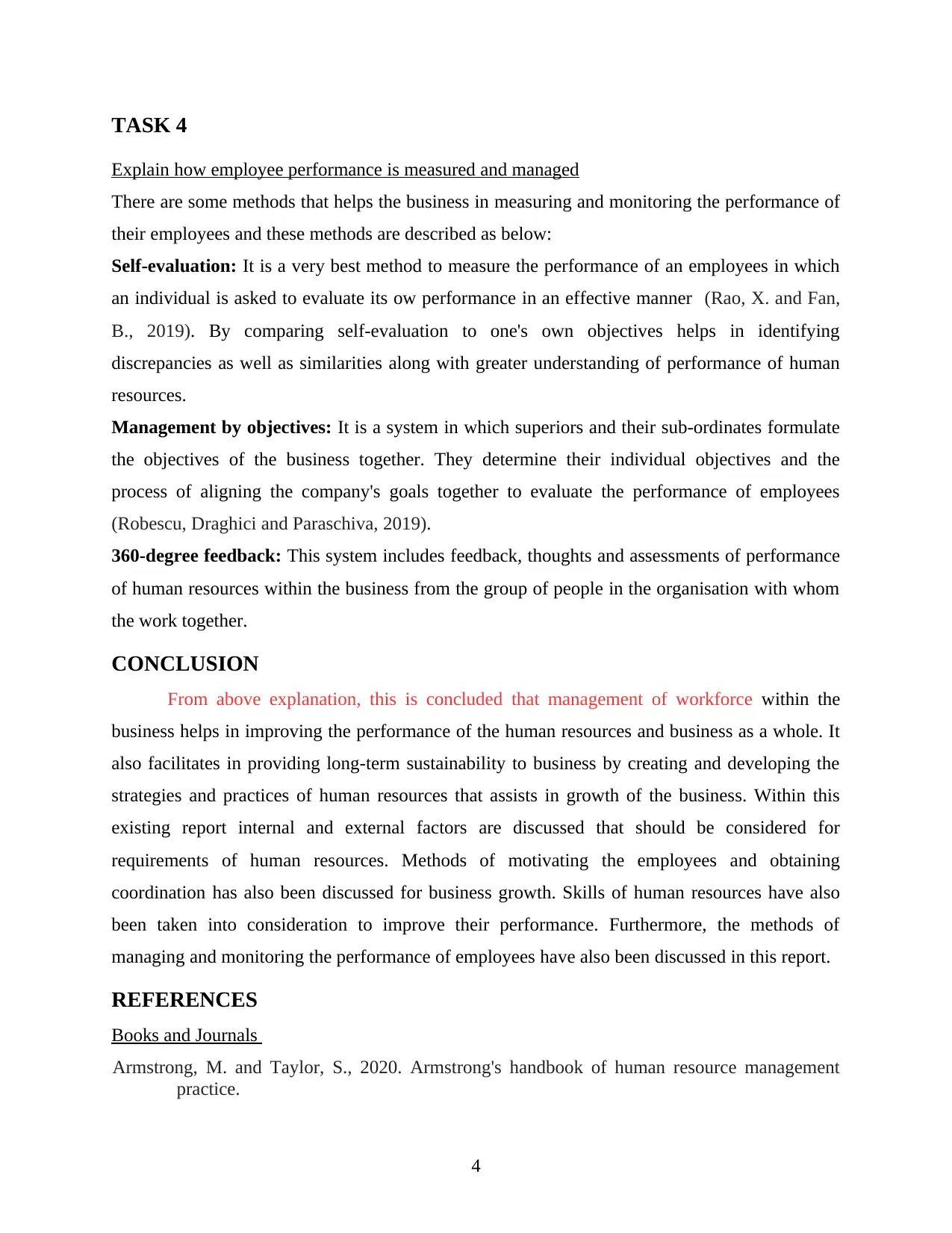
TASK 4
Explain how employee performance is measured and managed
There are some methods that helps the business in measuring and monitoring the performance of
their employees and these methods are described as below:
Self-evaluation: It is a very best method to measure the performance of an employees in which
an individual is asked to evaluate its ow performance in an effective manner (Rao, X. and Fan,
B., 2019). By comparing self-evaluation to one's own objectives helps in identifying
discrepancies as well as similarities along with greater understanding of performance of human
resources.
Management by objectives: It is a system in which superiors and their sub-ordinates formulate
the objectives of the business together. They determine their individual objectives and the
process of aligning the company's goals together to evaluate the performance of employees
(Robescu, Draghici and Paraschiva, 2019).
360-degree feedback: This system includes feedback, thoughts and assessments of performance
of human resources within the business from the group of people in the organisation with whom
the work together.
CONCLUSION
From above explanation, this is concluded that management of workforce within the
business helps in improving the performance of the human resources and business as a whole. It
also facilitates in providing long-term sustainability to business by creating and developing the
strategies and practices of human resources that assists in growth of the business. Within this
existing report internal and external factors are discussed that should be considered for
requirements of human resources. Methods of motivating the employees and obtaining
coordination has also been discussed for business growth. Skills of human resources have also
been taken into consideration to improve their performance. Furthermore, the methods of
managing and monitoring the performance of employees have also been discussed in this report.
REFERENCES
Books and Journals
Armstrong, M. and Taylor, S., 2020. Armstrong's handbook of human resource management
practice.
4
Explain how employee performance is measured and managed
There are some methods that helps the business in measuring and monitoring the performance of
their employees and these methods are described as below:
Self-evaluation: It is a very best method to measure the performance of an employees in which
an individual is asked to evaluate its ow performance in an effective manner (Rao, X. and Fan,
B., 2019). By comparing self-evaluation to one's own objectives helps in identifying
discrepancies as well as similarities along with greater understanding of performance of human
resources.
Management by objectives: It is a system in which superiors and their sub-ordinates formulate
the objectives of the business together. They determine their individual objectives and the
process of aligning the company's goals together to evaluate the performance of employees
(Robescu, Draghici and Paraschiva, 2019).
360-degree feedback: This system includes feedback, thoughts and assessments of performance
of human resources within the business from the group of people in the organisation with whom
the work together.
CONCLUSION
From above explanation, this is concluded that management of workforce within the
business helps in improving the performance of the human resources and business as a whole. It
also facilitates in providing long-term sustainability to business by creating and developing the
strategies and practices of human resources that assists in growth of the business. Within this
existing report internal and external factors are discussed that should be considered for
requirements of human resources. Methods of motivating the employees and obtaining
coordination has also been discussed for business growth. Skills of human resources have also
been taken into consideration to improve their performance. Furthermore, the methods of
managing and monitoring the performance of employees have also been discussed in this report.
REFERENCES
Books and Journals
Armstrong, M. and Taylor, S., 2020. Armstrong's handbook of human resource management
practice.
4
⊘ This is a preview!⊘
Do you want full access?
Subscribe today to unlock all pages.

Trusted by 1+ million students worldwide
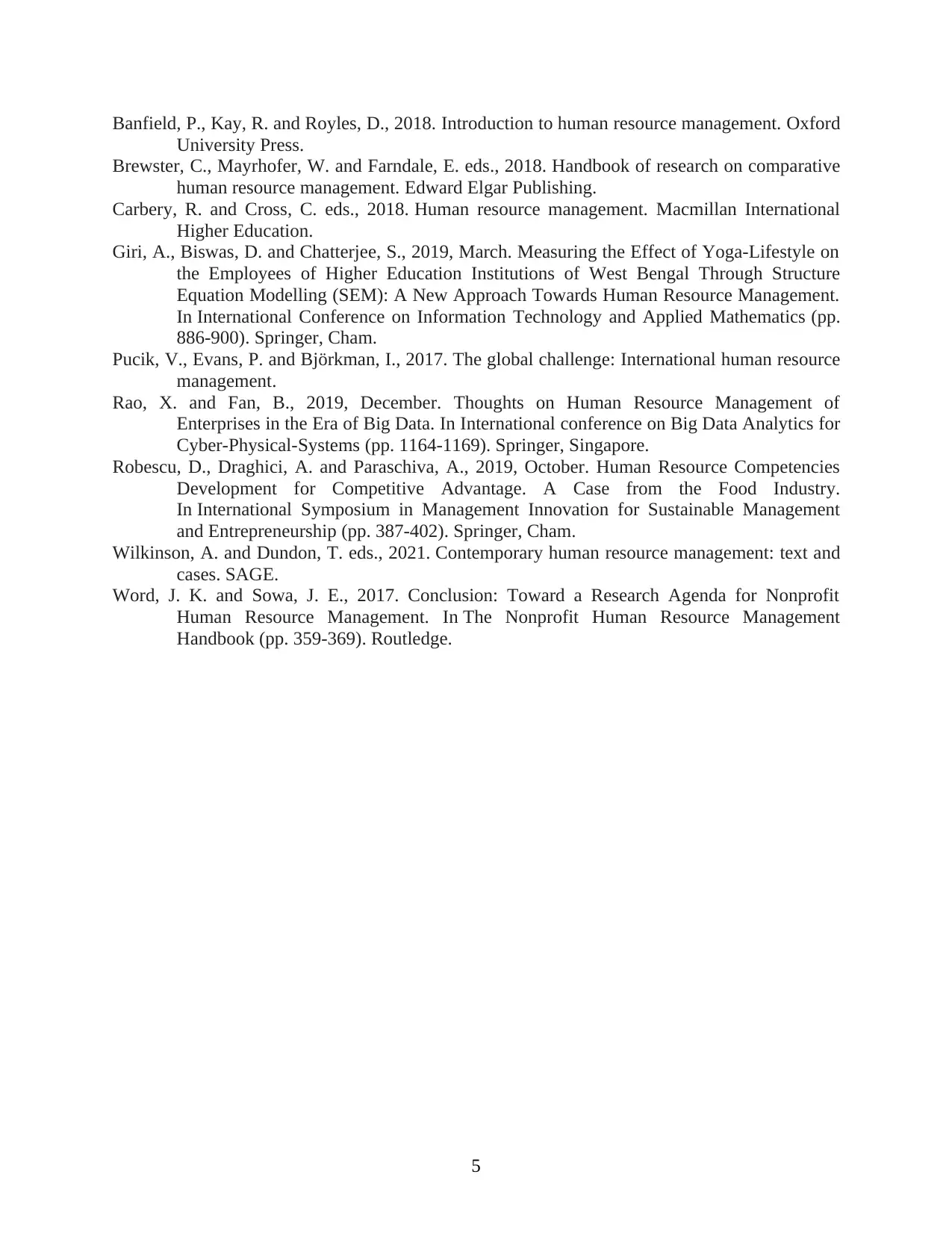
Banfield, P., Kay, R. and Royles, D., 2018. Introduction to human resource management. Oxford
University Press.
Brewster, C., Mayrhofer, W. and Farndale, E. eds., 2018. Handbook of research on comparative
human resource management. Edward Elgar Publishing.
Carbery, R. and Cross, C. eds., 2018. Human resource management. Macmillan International
Higher Education.
Giri, A., Biswas, D. and Chatterjee, S., 2019, March. Measuring the Effect of Yoga-Lifestyle on
the Employees of Higher Education Institutions of West Bengal Through Structure
Equation Modelling (SEM): A New Approach Towards Human Resource Management.
In International Conference on Information Technology and Applied Mathematics (pp.
886-900). Springer, Cham.
Pucik, V., Evans, P. and Björkman, I., 2017. The global challenge: International human resource
management.
Rao, X. and Fan, B., 2019, December. Thoughts on Human Resource Management of
Enterprises in the Era of Big Data. In International conference on Big Data Analytics for
Cyber-Physical-Systems (pp. 1164-1169). Springer, Singapore.
Robescu, D., Draghici, A. and Paraschiva, A., 2019, October. Human Resource Competencies
Development for Competitive Advantage. A Case from the Food Industry.
In International Symposium in Management Innovation for Sustainable Management
and Entrepreneurship (pp. 387-402). Springer, Cham.
Wilkinson, A. and Dundon, T. eds., 2021. Contemporary human resource management: text and
cases. SAGE.
Word, J. K. and Sowa, J. E., 2017. Conclusion: Toward a Research Agenda for Nonprofit
Human Resource Management. In The Nonprofit Human Resource Management
Handbook (pp. 359-369). Routledge.
5
University Press.
Brewster, C., Mayrhofer, W. and Farndale, E. eds., 2018. Handbook of research on comparative
human resource management. Edward Elgar Publishing.
Carbery, R. and Cross, C. eds., 2018. Human resource management. Macmillan International
Higher Education.
Giri, A., Biswas, D. and Chatterjee, S., 2019, March. Measuring the Effect of Yoga-Lifestyle on
the Employees of Higher Education Institutions of West Bengal Through Structure
Equation Modelling (SEM): A New Approach Towards Human Resource Management.
In International Conference on Information Technology and Applied Mathematics (pp.
886-900). Springer, Cham.
Pucik, V., Evans, P. and Björkman, I., 2017. The global challenge: International human resource
management.
Rao, X. and Fan, B., 2019, December. Thoughts on Human Resource Management of
Enterprises in the Era of Big Data. In International conference on Big Data Analytics for
Cyber-Physical-Systems (pp. 1164-1169). Springer, Singapore.
Robescu, D., Draghici, A. and Paraschiva, A., 2019, October. Human Resource Competencies
Development for Competitive Advantage. A Case from the Food Industry.
In International Symposium in Management Innovation for Sustainable Management
and Entrepreneurship (pp. 387-402). Springer, Cham.
Wilkinson, A. and Dundon, T. eds., 2021. Contemporary human resource management: text and
cases. SAGE.
Word, J. K. and Sowa, J. E., 2017. Conclusion: Toward a Research Agenda for Nonprofit
Human Resource Management. In The Nonprofit Human Resource Management
Handbook (pp. 359-369). Routledge.
5
1 out of 7
Related Documents
Your All-in-One AI-Powered Toolkit for Academic Success.
+13062052269
info@desklib.com
Available 24*7 on WhatsApp / Email
![[object Object]](/_next/static/media/star-bottom.7253800d.svg)
Unlock your academic potential
Copyright © 2020–2025 A2Z Services. All Rights Reserved. Developed and managed by ZUCOL.



